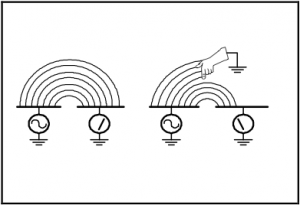All living organisms produce electrical signals — if you are alive, there is a voltage being produced somewhere in your body. Sharks and other submarine predators use this fact to catch their prey without even seeing them, locating them by sensing the voltage they produce. Below is a picture of a hammerhead shark scanning for buried fish below the sand; the red waves represent the range of the shark’s electroreceptors.
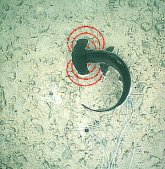 Sharks have ampullae of Lorenzini, poor like organs on their nose, that can sense the voltage difference between the back of the gell-filled orifice and the sea water outside. Because water — especially salt water — is highly conductive (at least relative to the innert gasses that compose most of our atmosphere), sharks use “passive electroreception” — they dont have to generate an electric field, their ampullae of Lorenzini are capable of sensing as little as 5 nano-volts/cm just by passing by within range.
Sharks have ampullae of Lorenzini, poor like organs on their nose, that can sense the voltage difference between the back of the gell-filled orifice and the sea water outside. Because water — especially salt water — is highly conductive (at least relative to the innert gasses that compose most of our atmosphere), sharks use “passive electroreception” — they dont have to generate an electric field, their ampullae of Lorenzini are capable of sensing as little as 5 nano-volts/cm just by passing by within range.
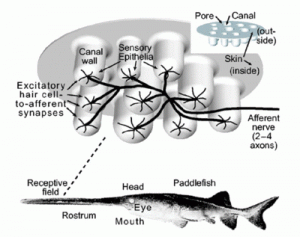
 Because the sensors are placed in an array on the sharks snout, the shark can locate voltages by comparing different readings from different ampullae. This provides them with a depiction of their environment much the same way a ship might use radar, but with unmatched precision and efficiency.
Because the sensors are placed in an array on the sharks snout, the shark can locate voltages by comparing different readings from different ampullae. This provides them with a depiction of their environment much the same way a ship might use radar, but with unmatched precision and efficiency.
 Some fish have evolved “active electroreception,” in which they create an electric field around them and sense objects by perceiving disruptions in that field. This is what the eel below is doing — the conductive object pulls the field into it, while the resistive object pushes the field away. This way the fish can tell the difference between a rock and another fish, and the location of both.
Some fish have evolved “active electroreception,” in which they create an electric field around them and sense objects by perceiving disruptions in that field. This is what the eel below is doing — the conductive object pulls the field into it, while the resistive object pushes the field away. This way the fish can tell the difference between a rock and another fish, and the location of both.
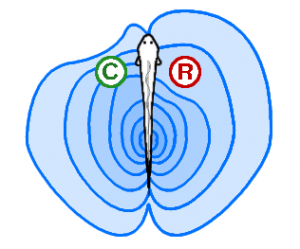 The MIT Media Lab made a sensor that works similarly to these in 2000. It consists of two electrodes, a transceiver and a receiver, that create a weak but stable electrical field between them. The device is able to sense the presence of organic forms by either measuring a drop in the signal due to connection to ground or an increase in signal due to conductive bodies, depending on its setting and application. As the manual says, “The sensor functions by detecting minute changes in an ultra-low-power electric field generated between two remotely locatable antenna electrodes.”
The MIT Media Lab made a sensor that works similarly to these in 2000. It consists of two electrodes, a transceiver and a receiver, that create a weak but stable electrical field between them. The device is able to sense the presence of organic forms by either measuring a drop in the signal due to connection to ground or an increase in signal due to conductive bodies, depending on its setting and application. As the manual says, “The sensor functions by detecting minute changes in an ultra-low-power electric field generated between two remotely locatable antenna electrodes.”
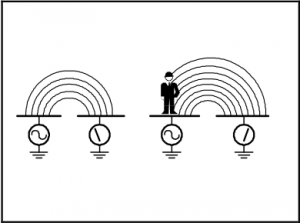 While useful for reducing false-alarms in home automation and other applications where sensing body presence is the goal, this sensor does a great job. However, unlike the shark’s electroreception, MIT’s sensor cannot tell where a body is. To do that, it would take an array of these sensors and the ability to distinguish the differences in field disturbance between each sensor and process this information into a sort of voltage map.
While useful for reducing false-alarms in home automation and other applications where sensing body presence is the goal, this sensor does a great job. However, unlike the shark’s electroreception, MIT’s sensor cannot tell where a body is. To do that, it would take an array of these sensors and the ability to distinguish the differences in field disturbance between each sensor and process this information into a sort of voltage map. 
